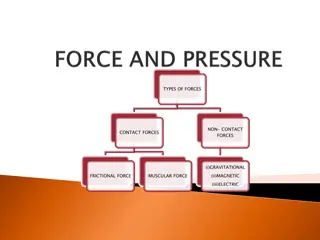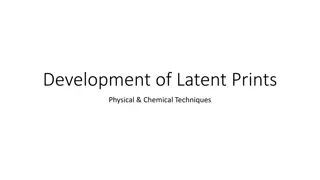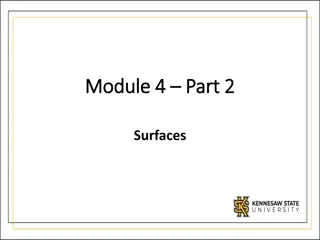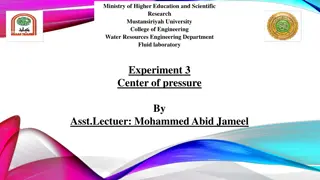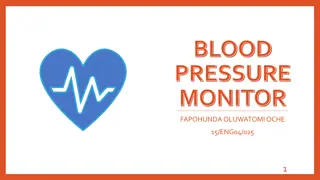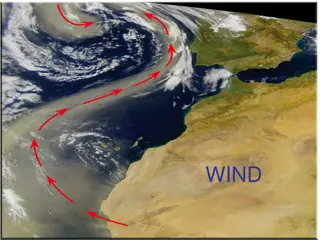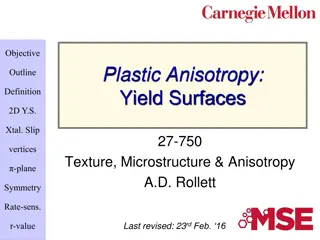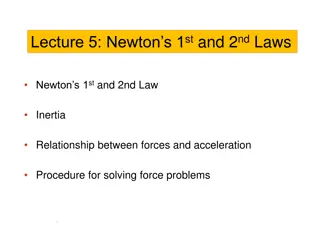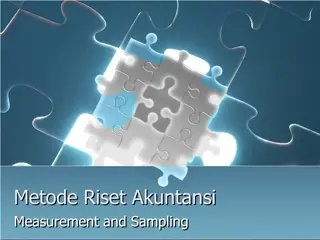Understanding Pressure Measurement and Hydrostatic Forces on Surfaces
Measurement of pressure using various gauges like Bourdon and Diaphragm Gauge, different types of pressure gauges like Bellows and Dead Weight Pressure Gauge are discussed. Piezometer and different types of manometers for pressure measurement are also explained. Additionally, the concept of hydrostatic forces on surfaces due to liquid head and normal pressure intensity is elaborated, including formulas for calculating total pressure and hydrostatic force on a horizontal plane.
Download Presentation

Please find below an Image/Link to download the presentation.
The content on the website is provided AS IS for your information and personal use only. It may not be sold, licensed, or shared on other websites without obtaining consent from the author. Download presentation by click this link. If you encounter any issues during the download, it is possible that the publisher has removed the file from their server.
E N D
Presentation Transcript
PRESSURE MEASUREMENT AND HYDROSTATIC FORCES ON SURFACES J. Badshah SGIDT, Patna (Bihar Animal Sciences University, Patna)
MEASUREMENT OF PRESSURE MEASUREMENT OF PRESSURE Measurement of Gauge Pressure Bourdon Gauge: It consists of a tube of elliptical cross section, bent in the form of a circular arc. It is fixed to the frame at one end and the other end is attached to a lever arrangement consisting of a link and a pointer on a scale. Compound Gauge: It is a combination of a pressure gauge and the vacuum gauge. Diaphragm Gauge: The corrugated diapragm is made up of elastic steel. The deformation of the diaphragm caused by
MEASUREMENT OF PRESSURE MEASUREMENT OF PRESSURE pressure is transmitted to the pointer Bellow Pressure Gauge: Thin metallic tubes having deep circumferential corrugations is called bellows, which can expand on sensing pressure. As the pressure increases bellows expand and vice- versa. The movement is transmitted to the pointer on circular dial. Dead Weight Pressure Gauge: It consists of a cylinder and plunger arrangement. The fluid under pressure enters the cylinder and exerts a force on the plunger. The weight placed on the top of the plunger balance the pressure force. The pressure intensity of the fluid is p = W/ /4 d2
MEASUREMENT OF PRESSURE Piezometer For positive pressure an open manometer is known as piezometer. Piezometer For negative measurement, the liquid in open leg is depressed. U-tube Manometers the point at the same levels are at equal pressure. Differential Manometers: The only difference in procedure from open manometers is that the starting point is a pressure not zero. There may be three different fluids. pressure
MEASUREMENT OF PRESSURE Inverted Differential Manometers: When there is small pressure difference between two points, an inverted differential manometer may be used for greater accuracy. Top portion of the tube is filled with air. Single Tube Manometer Vertical Type: If a reservoir of large cross sectional area is fitted in one leg, the change in the level of liquid in the reservoir is very small, the pressure can be measured by observing change in the level of liquid in the other leg. Single Tube Manometer- Inclined type: For more accuracy, the other leg may be inclined, while there is reservoir in first leg of open manaometers. Micrometer: They are used for precise measurement of pressure. Alarge reservoir is fitted on each leg of the tube of manometers
HYDROSTATIC FORCES ON SURFACES The magnitude and direction of total pressure on the surface due to liquid head with the liquid pressure intensity normal to the surface is termed as hydrostatic forces or hydrostatic total pressure. Hydrostatic Forces on horizontal plane dP = h dA Total pressure or hydrostatic force = h dA Hydrostatic Force on Horizontal Plane of area A = A (hbar) hbar = Depth of centroid of the entire area below the free surface; since whole area is horizontal h = hbar
HYDROSTATIC FORCE ON VERTICAL PLANE Plane surface of Area is immersed vertically. At every depth, the pressure intensity varies. Let us consider a narrow strip area dA at a depth of h below the free surface. The total pressure or force on the strip dP = h dA Total Pressure on one side of the entire area P = h dA = h dA = A hbar hbar = Depth of the centroid below the free surface Total pressure on an irregular shapes vertical area = P = Y [A1h1+A2h2+-----]
CENTRE OF PRESSURE The centre of pressure is the point on the immersed surface at which the total pressure on the entire area may be assumed to act. It can be determined by equating the Moment caused by total pressure about the free surface to the moment of the number of forces about the same axis. Let us assume that the depth of centre of pressure on a horizontal and vertical plane be h . In horizontal plane h = hbar = h but in vertical plane it can be estimated by : Assume a small strip of area dA over which a total pressure of dP acts, which is at h distance from the free surface of water. The moment of the force dP about the free surface of water dM = dP h = Yh dAh
CENTRE OF PRESSURE Total moment of forces on whole area = M = Yh2dA = If Total Pressure or Force is P, its moment about the free surface of water is Ph Therefore Ph = Yh2dA and h = Yh2dA /P = Y h2dA /P = Y Ioo/P Ioo is the second moment of area about the free surface. From the parallel axis theorem of the moment of inertia Ioo= IG+ A (hbar )2 Therefore h = Y (IG+ A (hbar )2) / YA (hbar)
CENTRE OF PRESSURE h = IG/A(hbar) + hbar h = Akg2/A hbar + hbar h = (kg2/ hbar) + hbar For Irregular Shapes, centre of Pressure h = P1 h1 + P2h2+ P3h3/ (P1 +P2 + P3) Where, P1 = YA1H1, P2= YA2h2, P3= YA3h3 Y = gama = Specific weight of liquid It has been proved that the depth of centre of pressure of a rectangular of height h with upper edge at the free surface is given by 2/3 h i.e. h =2/3 h Total pressure per m = area of pressure distribution diagram triangle = Y h2/2





